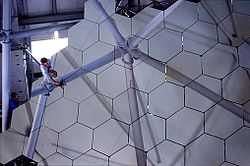Segmented mirror

A segmented mirror is an array of smaller mirrors designed to act as segments of a single large curved mirror. The segments can be either spherical or asymmetric (if they are part of a larger parabolic reflector[2]). They are used as objectives for large reflecting telescopes. To function, all the mirror segments have to be polished to a precise shape and actively aligned by a computer controlled active optics system using actuators built into the mirror support cell. The concept and necessary technologies were initially developed under the leadership of Dr. Jerry Nelson at the Lawrence Berkeley National Laboratory and University of California during the 1980s, and have since spread worldwide to the point that essentially all future large optical telescopes plan to use segmented mirrors.
Application

Because current monolithic mirrors cannot be constructed larger than about eight meters in diameter, the use of segmented mirrors is a key component of current large-aperture telescopes. This is because of the technological limit of a primary mirror made of a single rigid piece of glass.[3][4] Using a monolithic mirror much larger than 5 meters is prohibitively expensive due to the cost of both the mirror, and the massive structure needed to support it. A mirror beyond that size would also sag slightly under its own weight as the telescope was rotated to different positions,[5][6] changing the precision shape of the surface. Segments are also easier to fabricate, transport, install, and maintain over very large monolithic mirrors.
Segmented mirrors do have the drawback that each segment may require some precise asymmetrical shape, and rely on a complicated computer-controlled mounting system. All of the segments also cause diffraction effects in the final image.
Current segmented-mirror telescopes
These include, but are not limited to:
- The twin W. M. Keck Telescopes
- The Hobby-Eberly Telescope
- The Southern African Large Telescope
- The Gran Telescopio Canarias (GTC) 36 segmented mirror [7][8]
The James Webb Space Telescope's 18 mirror segments have mostly been fabricated as of spring 2011 [9] but the spacecraft is not expected to be launched until 2017 or 2018.
Proposed segmented-mirror telescopes
These telescopes represent the next generation of segmented mirror telescopes; they are currently at least a decade from completion.
- TMT, the North American Thirty meter telescope
- E-ELT, European Extremely Large Telescope
- The Giant Magellan Telescope, uses very large segments and is either grouped with segmented mirrors telescopes or its own category.
References
- ↑ "ESO E-ELT Programme Confirmed". ESO Announcement. Retrieved 7 December 2012.
- ↑ W. Patrick McCray - Giant telescopes - Page 107
- ↑ Nickerson, Colin (2007-11-05). Long time no see. Boston Globe. Retrieved 2009-11-11.
- ↑ "Keck telescope science kit fact sheet, Part 1". SCI Space Craft International. 2009. Retrieved 2009-11-11.
- ↑ Bobra, Monica Godha (September, 2005). The endless mantra: Innovation at the Keck Observatory. MIT. Retrieved 2009-11-11.
- ↑ Yarris, Lynn (Winter 1992). "Revolution in telescope design debuts at Keck after birth here". Science@Berkeley Lab. Lawrence Berkeley Laboratory. Retrieved 2009-11-11.
- ↑ Tests begin on Canaries telescope BBC 14 July 2007
- ↑ Giant telescope begins scouring space July 14, 2007
- ↑ "Six JWST Mirror Segments to Begin Cryogenic Tests" news.softpedia.com 14 April 2011